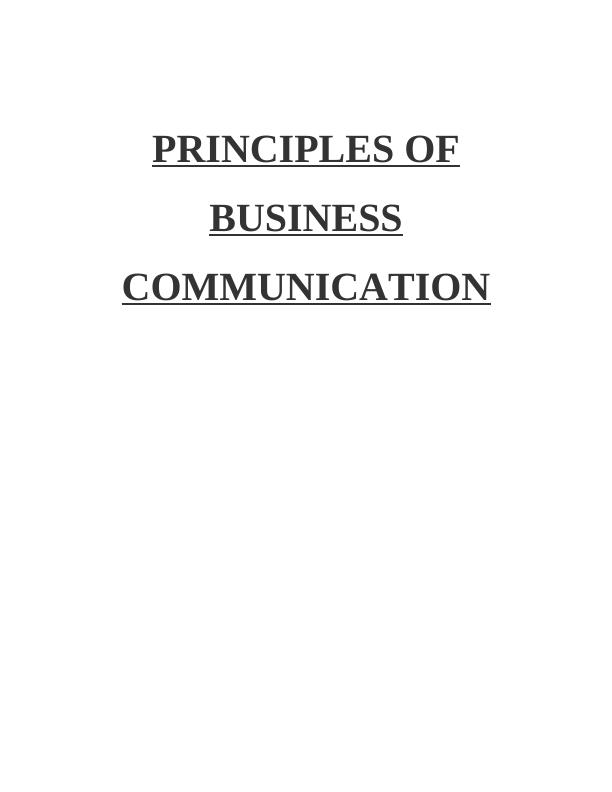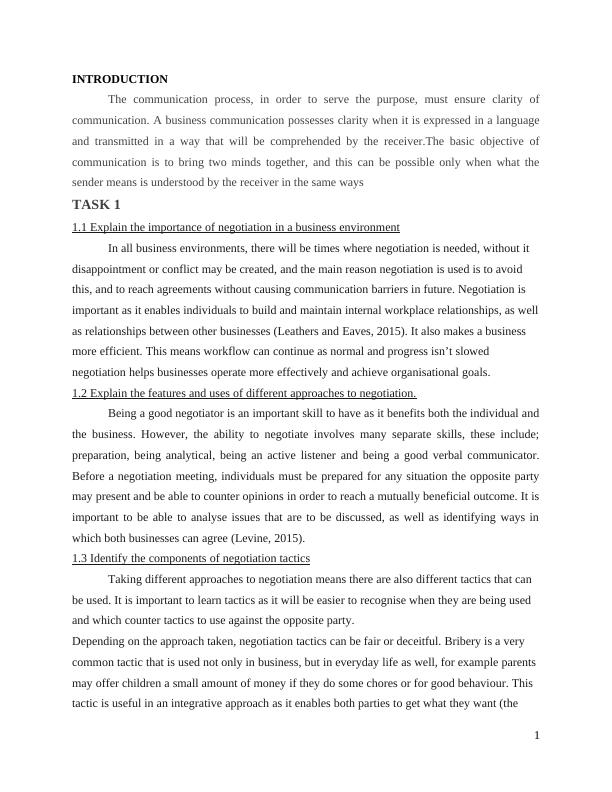Principles of Business Communication Report Sample
Added on 2020-07-22
11 Pages3012 Words126 Views
PRINCIPLES OFBUSINESSCOMMUNICATION

Table of ContentsINTRODUCTION ..........................................................................................................................1TASK 1............................................................................................................................................11.1 Explain the importance of negotiation in a business environment.......................................11.2 Explain the features and uses of different approaches to negotiation...................................11.3 Identify the components of negotiation tactics.....................................................................1TASK 2 ...........................................................................................................................................22.1 Explain the different types of presentations and their requirements.....................................22.2 Explain how different resources can be used to develop a presentation...............................22.3 Explain different methods of giving presentations...............................................................22.4 Explain the best practice in delivering presentations............................................................32.5 Explain how to collect and use feedback on a presentation..................................................3TASK 3............................................................................................................................................43.1 Explain the characteristics of bespoke documents................................................................43.2 Explain the factors to be taken into account in creating and presenting bespoke documents......................................................................................................................................................43.3 Explain the legal requirements and procedures for gathering information for bespokedocuments...................................................................................................................................43.4 Explain techniques to create bespoke business documents...................................................43.5 Explain how to gain approval of bespoke documents...........................................................5TASK 4............................................................................................................................................54.1 Explain the typical stages of information systems development..........................................54.2 analyse the benefits and limitations of different information system...................................54.3 Explain legal security and confidentially requirement for information systems in abusiness environment. ................................................................................................................64.4 Explain how to monitor the use and effectiveness of an information ..................................6CONCLUSION ...............................................................................................................................7

INTRODUCTION The communication process, in order to serve the purpose, must ensure clarity ofcommunication. A business communication possesses clarity when it is expressed in a languageand transmitted in a way that will be comprehended by the receiver.The basic objective ofcommunication is to bring two minds together, and this can be possible only when what thesender means is understood by the receiver in the same waysTASK 11.1 Explain the importance of negotiation in a business environmentIn all business environments, there will be times where negotiation is needed, without it disappointment or conflict may be created, and the main reason negotiation is used is to avoid this, and to reach agreements without causing communication barriers in future. Negotiation is important as it enables individuals to build and maintain internal workplace relationships, as wellas relationships between other businesses (Leathers and Eaves, 2015). It also makes a business more efficient. This means workflow can continue as normal and progress isn’t slowed negotiation helps businesses operate more effectively and achieve organisational goals. 1.2 Explain the features and uses of different approaches to negotiation.Being a good negotiator is an important skill to have as it benefits both the individual andthe business. However, the ability to negotiate involves many separate skills, these include;preparation, being analytical, being an active listener and being a good verbal communicator.Before a negotiation meeting, individuals must be prepared for any situation the opposite partymay present and be able to counter opinions in order to reach a mutually beneficial outcome. It isimportant to be able to analyse issues that are to be discussed, as well as identifying ways inwhich both businesses can agree (Levine, 2015). 1.3 Identify the components of negotiation tacticsTaking different approaches to negotiation means there are also different tactics that can be used. It is important to learn tactics as it will be easier to recognise when they are being used and which counter tactics to use against the opposite party.Depending on the approach taken, negotiation tactics can be fair or deceitful. Bribery is a very common tactic that is used not only in business, but in everyday life as well, for example parents may offer children a small amount of money if they do some chores or for good behaviour. This tactic is useful in an integrative approach as it enables both parties to get what they want (the 1

parent gets a clean house, and the child receives money). From a business point of view, the incentives could include bigger shares, information about a particular product or more advertising (Cornelissen and Cornelissen, 2017). TASK 2 2.1 Explain the different types of presentations and their requirementsPresentations come in a lot of different forms and have a variety of purposes. In the business world, there are six main types of presentations.1. Providing Information. This format encompasses anything from a team meeting that gives updates on a project or upcoming event to a demonstration that shows product functions. Informative presentation are very brief and to the point and factual.2. Making a Decision. It’s time for the annual holiday party and ideas are being tossed around the office. When giving your input on the location, make sure to share the must-haves and nice-to-haves for the event. When it’s time for the final decision, you can see how your idea stacks upto the other options. Decision making presentation are more about the audience taking suggested action. The audience are told what to do and how to do it (Wu, 2016).2.2 Explain how different resources can be used to develop a presentationTo ensure a presentation is effective, presenters should implement a range of different resources. Providing hand-outs is a very easy way to allow the audience to take notes if they need to, as well as explaining key points/technical terms from within the presentation. Producing hand-outs allows the presenter to give more detailed information whilst saving time to present the important parts, as well as giving the audience a copy of any diagrams or graphs that may be needed in future. Hand-outs should be produced on good quality paper in order to leave a good impression with the audience. Hand-outs should be given out before.2.3 Explain different methods of giving presentationsThere are many different types of presentation and each has a different effect on theaudience depending on the purpose. Presentations can be displayed in a number of ways;electronically, paper based using audience hand-outs, via video link e.g. internationalconferences, via a face-to-face discussion etc (van Ginkel, Gulikers and Mulder, 2015). Usually,presentations fit into one of four categories; informative, instructional, educational or persuasive.Each of these will have similar content and some themes may overlap, however all types of2

End of preview
Want to access all the pages? Upload your documents or become a member.
Related Documents
Principle of Business Communicationslg...
|11
|2801
|29
Principles of Business Communication Essaylg...
|10
|2982
|62
Principles of Business Communication : Assignmentlg...
|10
|3008
|65
Principles of Business Communication - Essaylg...
|10
|3101
|97
Principles of Business Communicationlg...
|13
|3315
|74
Principles of Business Communication and Information - Reportlg...
|12
|2669
|76
